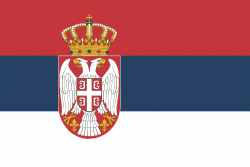Tutin (Opština Tutin)
 |
The settlement of Gluhavica in the territory of Tutin is likely the oldest village attested by name in the municipality. It was an iron mining center of Stefan Milutin, King of Serbia in the early 14th century. After the battle of Kosovo (1389), the Gluhavica mine was the first to be placed under direct Ottoman control in the area. A kadi of Gluhavica is attested as early as 1396.
There is no information about the foundation of the town of Tutin and its etymology is unknown. The village is mentioned for the first time in an 1868 travelogue by British writer M. Mackenzie. In 1700, after the Great Serb Migration, the Albanian Kelmendi and Kuçi and other Albanian tribes like the Shkreli of Rugova established themselves in the region of Rožaje and the neighboring town of Tutin in Serbia. The Shala, Krasniqi, and Gashi also moved into the region. Starting in the 18th century many people originating from the Hoti tribe have migrated to and live in Sandžak, mainly in the Tutin area, but also in Sjenica. Catholic Albanian groups which settled in Tutin in the early 18th century were converted to Islam in that period. Their descendants make up the large majority of the population of Tutin and the Pešter plateau.
The name of Tutin first appeared in 1868 in the work of English travelers. According to that work, Tutin had only 7 houses of which 6 belonged to the Hamzagić family and one was Serb. Until 1912, Tutin was a small settlement with 20 houses. In the 20th century, the settlement was greatly developed: public buildings, a health station, a school and shops were built. During World War II, Tutin belonged to the Italian protectorate of Albania from 1941 to 1943 and to the Albanian Kingdom from 1943 to 1944, which was a client state of Nazi Germany.
Tutin was the first municipality in Serbia to have renewable wind power. It was opened in 2011 with an installed capacity of 600 KW.
Map - Tutin (Opština Tutin)
Map
Country - Serbia
 |
 |
| Flag of Serbia | |
Continuously inhabited since the Paleolithic Age, the territory of modern-day Serbia faced Slavic migrations in the 6th century, establishing several regional states in the early Middle Ages at times recognised as tributaries to the Byzantine, Frankish and Hungarian kingdoms. The Serbian Kingdom obtained recognition by the Holy See and Constantinople in 1217, reaching its territorial apex in 1346 as the Serbian Empire. By the mid-16th century, the Ottomans annexed the entirety of modern-day Serbia; their rule was at times interrupted by the Habsburg Empire, which began expanding towards Central Serbia from the end of the 17th century while maintaining a foothold in Vojvodina. In the early 19th century, the Serbian Revolution established the nation-state as the region's first constitutional monarchy, which subsequently expanded its territory. Following casualties in World War I, and the subsequent unification of the former Habsburg crownland of Vojvodina with Serbia, the country co-founded Yugoslavia with other South Slavic nations, which would exist in various political formations until the Yugoslav Wars of the 1990s. During the breakup of Yugoslavia, Serbia formed a union with Montenegro, which was peacefully dissolved in 2006, restoring Serbia's independence as a sovereign state for the first time since 1918. In 2008, representatives of the Assembly of Kosovo unilaterally declared independence, with mixed responses from the international community while Serbia continues to claim it as part of its own sovereign territory.
Currency / Language
| ISO | Currency | Symbol | Significant figures |
|---|---|---|---|
| RSD | Serbian dinar | дин or din. | 2 |
| ISO | Language |
|---|---|
| BS | Bosnian language |
| HU | Hungarian language |
| SR | Serbian language |
















